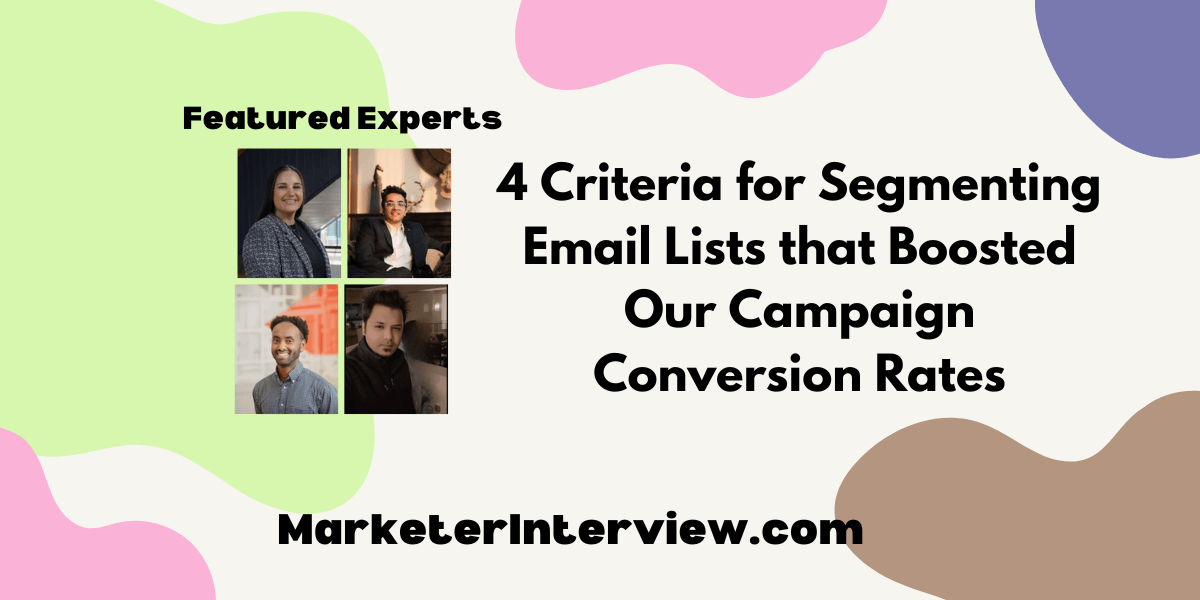4 Criteria for Segmenting Email Lists that Boosted Our Campaign Conversion Rates
Discover how precise email list segmentation can significantly enhance campaign conversion rates, as recounted by top marketing professionals. From a marketing analyst’s success with segmented trade show attendee follow-ups to a digital marketer’s boost in e-commerce sales through purchase history and customer demographics, explore the diverse strategies and criteria used in these four compelling case studies.
Want to get quoted in MarketerInterview.com content just like this? Apply to become a contributor today!
Contents
Follow-ups for Decision-makers
When going to a trade show/expo, you can purchase a list of attendees. Throughout the event, we mark the individuals we’ve talked to at the trade show.
After the event, we run a drip email campaign. In this campaign, we separate those that we’ve talked to (warm leads), those that are decision-makers (C-level executives to start using our software), and others (could include those that are great for partnerships). Each segmentation gets a different email based on the objectives we want.

Mose Gebremeskel, Marketing Analyst, Innago
Engagement Metrics
One standout method for enhancing conversion rates involves segmenting the email list according to subscriber engagement metrics. I began by analyzing metrics such as open rates, click-through rates, and email interaction frequency, to categorize subscribers into highly engaged, moderately engaged, and disengaged segments.
Tailoring email content and incentives to match each segment’s level of engagement and interests led to increased responsiveness and conversion rates. Implementing re-engagement strategies specifically for inactive subscribers within the disengaged segment helped revitalize interest and drive conversions. This approach not only optimized campaign performance but also fostered a more personalized and targeted communication strategy, ultimately enhancing overall email retention efforts.

Taylor Caplan, Marketing Manager, Duckpin
Subject’s Choice of Interest
An online fashion store that operates in the e-commerce domain aims to sell the latest collections at reasonable prices. According to the segmentation, the email list was based on purchases made in the past and the levels at which customers had been engaging.
Evaluating our existing subscribers who have made more than six purchases in the past six months, those who hadn’t opened an email in the last three months, and those who haven’t made a single purchase yet was carried out.
As we had personalized our email content based on the segment’s choice of interests and behavioral patterns, we were able to cost-effectively initiate our CRM effort. The results were impressive: the campaign targeting loyal customers showed a 25% increase in engagement, the re-engagement campaign for inactive subscribers reached a 20% open rate, and the welcome series for new clients provoked a 15% growth in first-time purchases.

Kartik Ahuja, Digital Marketer, kartikahuja.com
Buying History and Demographics
My diverse customer base reflects various preferences, interests, and purchasing behaviors. When segmenting our email for a recent campaign, we initially targeted customers based on their buying history. Loyal customers were rewarded, while inactive ones received bonuses to re-engage them.
Another segmentation criterion was demographics, encompassing gender, age, location, and income. For example, men were offered savings on branded shirts, while women were offered budget-friendly options like jewelry. By tailoring our outreach to match individual preferences and tastes, we attracted more leads. This approach improved the conversion rates for our email marketing campaigns and boosted sales!

Faizan Khan, Public Relations and Content Marketing Specialist, Ubuy UK
Want to get quoted in MarketerInterview.com content just like this? Apply to become a contributor today!






